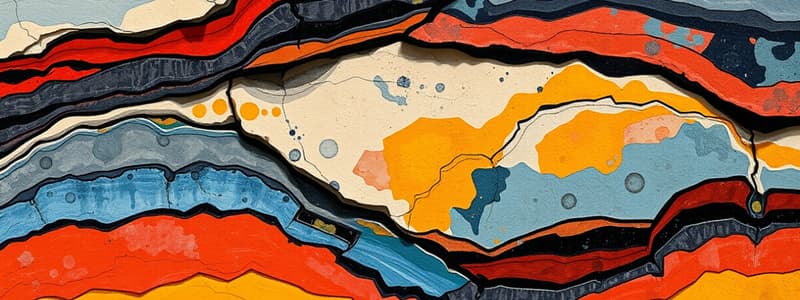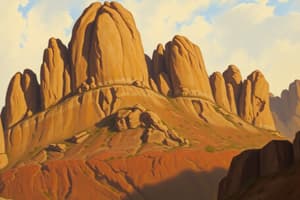Podcast
Questions and Answers
How do sedimentary rocks form?
How do sedimentary rocks form?
Sedimentary rocks form when small pieces of sediments are packed together.
What do other rocks need to become before they can become sedimentary rock?
What do other rocks need to become before they can become sedimentary rock?
They need to become sediment.
What two processes form sediments?
What two processes form sediments?
Weathering and erosion.
What three characteristics are used to classify sedimentary rocks?
What three characteristics are used to classify sedimentary rocks?
What are the three types of sedimentary rock?
What are the three types of sedimentary rock?
How do clastic sedimentary rocks form?
How do clastic sedimentary rocks form?
What are the four sizes of sediment that might make up a clastic rock?
What are the four sizes of sediment that might make up a clastic rock?
Name one rock that compacted sand might form.
Name one rock that compacted sand might form.
Name one rock that compacted clay might form.
Name one rock that compacted clay might form.
Give one example of a chemical sedimentary rock.
Give one example of a chemical sedimentary rock.
Name one type of organic matter that might be used to form an organic sedimentary rock.
Name one type of organic matter that might be used to form an organic sedimentary rock.
What does it mean if a sedimentary rock has a coarse texture?
What does it mean if a sedimentary rock has a coarse texture?
What does it mean if a sedimentary rock has fine texture?
What does it mean if a sedimentary rock has fine texture?
How is a crystalline rock different from a resinous rock?
How is a crystalline rock different from a resinous rock?
What does it mean if a rock has a glassy structure?
What does it mean if a rock has a glassy structure?
How do metamorphic rocks form?
How do metamorphic rocks form?
What does it mean if a rock is foliated?
What does it mean if a rock is foliated?
What is a parent rock?
What is a parent rock?
What is the parent rock of schist?
What is the parent rock of schist?
What is the parent rock of slate?
What is the parent rock of slate?
What is the parent rock of quartzite?
What is the parent rock of quartzite?
What are rocks?
What are rocks?
What is the continental crust?
What is the continental crust?
What is the oceanic crust?
What is the oceanic crust?
What is rock?
What is rock?
Most rocks contain?
Most rocks contain?
What does the rock cycle show?
What does the rock cycle show?
What is an igneous rock?
What is an igneous rock?
What is a metamorphic rock?
What is a metamorphic rock?
What is a sedimentary rock?
What is a sedimentary rock?
What does matter refer to?
What does matter refer to?
What are grains?
What are grains?
What do geologists use to classify rocks?
What do geologists use to classify rocks?
What is texture in rocks?
What is texture in rocks?
How is texture used to classify rocks?
How is texture used to classify rocks?
What does composition refer to in geology?
What does composition refer to in geology?
What is the temperature range of magma?
What is the temperature range of magma?
What is lava?
What is lava?
What is another heat source for the formation of igneous rocks?
What is another heat source for the formation of igneous rocks?
What is an intrusive igneous rock?
What is an intrusive igneous rock?
How do extrusive igneous rocks form?
How do extrusive igneous rocks form?
What are examples of volcanic glass?
What are examples of volcanic glass?
How to identify igneous rocks?
How to identify igneous rocks?
What is mafic (basaltic) rock?
What is mafic (basaltic) rock?
What is felsic rock?
What is felsic rock?
What is andesitic rock?
What is andesitic rock?
What are examples of igneous rocks?
What are examples of igneous rocks?
What are examples of metamorphic rocks?
What are examples of metamorphic rocks?
What are examples of sedimentary rocks?
What are examples of sedimentary rocks?
What does foliated mean?
What does foliated mean?
What does non-foliated mean?
What does non-foliated mean?
What percentage of rocks on the surface are sedimentary?
What percentage of rocks on the surface are sedimentary?
What are the classifications of sedimentary rocks?
What are the classifications of sedimentary rocks?
Define compaction.
Define compaction.
What is cementation?
What is cementation?
What are organic rocks made of?
What are organic rocks made of?
Flashcards are hidden until you start studying
Study Notes
Formation and Types of Sedimentary Rocks
- Sedimentary rocks form through the packing together of sediments.
- Pre-existing rocks must first be transformed into sediment to become sedimentary rocks.
- Sediments are generated through weathering (breaking down rock and soil) and erosion (movement of particles by wind or water).
Classification of Sedimentary Rocks
- Sedimentary rocks are classified based on rock type, texture, and structure.
- Three primary types of sedimentary rocks are:
- Clastic: Formed from pre-existing rocks pressed together.
- Chemical: Result from dissolution and precipitation of minerals, often involving evaporated solutions.
- Organic: Composed of compacted organic matter like decomposed plants.
Characteristics of Sediments
- Clastic sedimentary rocks can be categorized by the size of their sediment:
- Boulder size (e.g., conglomerate)
- Cobble, pebble, or granule size (e.g., breccia)
- Sand size (e.g., sandstone, graywacke)
- Finer sizes (e.g., siltstone, clay)
Texture and Structure of Rocks
- Coarse texture indicates large, visible particles in the rock.
- Fine texture suggests the absence of visible sediments.
- Crystalline rocks have a defined crystal structure, whereas resinous rocks resemble resin.
- A glassy structure appears shiny and smooth.
Formation of Metamorphic Rocks
- Metamorphic rocks develop from existing rocks subjected to high temperatures and pressures deep within the Earth.
- Foliation refers to the layering seen in some metamorphic rocks; they cleave along these layers.
- Parent rocks are the original rocks before metamorphism occurs, such as:
- Schist: Parent rock is phyllite.
- Slate: Parent rocks include shale and mudstone.
- Quartzite: Parent rock is sandstone.
Basic Concepts of Rocks and the Rock Cycle
- Rocks are aggregates of mineral crystals and can consist of rock fragments, volcanic glass, and organic materials.
- The continental crust is primarily granite, composed of quartz, biotite, and feldspar.
- The oceanic crust consists mainly of basalt, composed of pyroxene and olivine.
- Most rocks are made up of common minerals such as quartz, feldspar, mica, or calcite.
Rock Cycle Overview
- The rock cycle illustrates the slow transformation of rocks over time through various geological processes.
- Igneous rocks form from the cooling of magma or lava.
- Metamorphic rocks are altered by heat and pressure.
- Sedimentary rocks form from cemented sediments.
Identification and Composition
- Rocks can be identified based on grain size, shape, chemical composition, and texture.
- Grains are fragments that compose the rock.
- Igneous rocks can be classified as:
- Mafic (Basaltic): Dense, dark, high in iron and magnesium.
- Felsic: Less dense, lighter in color, high in aluminum and silicon.
- Andesitic: Intermediate composition between basaltic and granitic rocks.
Rock Examples and Classifications
- Common examples:
- Igneous Rocks: Basalt, obsidian.
- Metamorphic Rocks: Gneiss, marble.
- Sedimentary Rocks: Conglomerate, limestone.
- Foliated rocks show curvy, thin crystal lines, while non-foliated rocks lack such lines.
Geological Processes
- Compaction: Pressure from overlaying sediments compresses grains and expels pore water.
- Cementation: Pore spaces are filled with ions that precipitate from water, forming solid bonds.
Additional Key Facts
- Approximately 75% of rocks on the Earth's surface are sedimentary.
- Organic sedimentary rocks are formed from once-living materials.
Studying That Suits You
Use AI to generate personalized quizzes and flashcards to suit your learning preferences.




